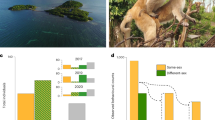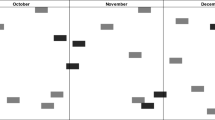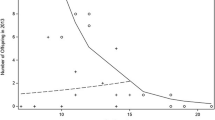Abstract
That a mother's relationship with her infant could influence her subsequent reproductive history can be argued as follows. A rhesus monkey infant whose next sibling is to be born in a succeeding birth season1 could compete with it by trying to postpone the date when its mother next conceives. If the mother preferred a shorter delay than the infant2, processes of conflict3 and negotiation4 involving the two could show in some of the behavioural interactions constituting their relationship5. For example, a mother could try to hasten the onset of her next pregnancy by trying to promote more independent behaviour in her infant, perhaps by rejecting some of its bids for contact3,4. We report here studies on our rhesus monkey colony and other colonies which support this argument.
This is a preview of subscription content, access via your institution
Access options
Subscribe to this journal
Receive 51 print issues and online access
$199.00 per year
only $3.90 per issue
Buy this article
- Purchase on Springer Link
- Instant access to full article PDF
Prices may be subject to local taxes which are calculated during checkout
Similar content being viewed by others
References
Anderson, D. M. & Simpson, M. J. A. Lab. Anim. 13, 275–281 (1979).
Trivers, R. L. Am. Zool. 14, 249–264 (1974).
Hinde, R. A. The Biological Bases of Human Social Behaviour (McGraw Hill, New York, 1974).
Altman, J. Baboon Mothers and Infants (Harvard University Press, 1980).
Hinde, R. A. Towards Understanding Relationships (Academic, London, 1979).
Siegel, S. Nonparametric Statistics (McGraw Hill, New York, 1956).
Hinde, R. A. & Spencer-Booth, Y. Anim. Behav. 15, 169–196 (1967).
Simpson, M. J. A. & Howe, S. Behaviour 72, 127–155 (1980).
Wilson, M. E., Gordon, T. P. & Bernstein, I. S. J. med. Primat. 7, 202–213 (1978).
Berman, C. M. Anim. Behav. 28, 860–873 (1980).
Harlow, H. F. in Sex and Behaviour (ed. Beach, F. A.) 234–265 (Wiley, New York, 1965).
Bonner, J., Franklin, M., Nott, P. N. & McNeilly, A. S. Br. med. J. 4, 82–84 (1975).
Delvoye, P., Badawi, M., Demaegd, M. & Robyn, C. in Progress in Prolactin Physiology and Pathology (eds Robyn, C. & Harter, M.) 213–232 (Elsevier, Amsterdam, 1978).
Bowman, L. A., Dilley, S. R. & Keverne, E. B. Nature 265, 56–58 (1978).
Simpson, M. J. A. in Social Interaction Analysis (eds Lamb, M. E., Suomi, S. J. & Stephenson, G. R.) 137–156 (University of Wisconsin Press, Madison, 1979).
Altmann, J., Altmann, S. A. & Hausfater, G. Science 210, 1028–1029 (1978).
Altmann, J. in The Development of Behaviour: Comparative and Evolutionary Aspects (eds Burghardt, G. M. & Bekoff, M.) 253–277 (Garland STP11, New York, 1978).
Suomi, S. J. in Minnesota Sym. Child Psychol. 10, 201–228 (1976).
Sackett, G. P., Holm, R. A., Davis, A. E. & Farenbruch, C. E. in Symp. 5th Congr. int. Primat. Soc. (eds Kondo, S., Kawai, M., Ehara, E. & Kawamura, S.) 189–205 (Japan Science, Tokyo, 1975).
Mitchell, G. D. Child Devl. 39, 611–620 (1968).
Trivers, R. L. & Willard, D. E. Science 179, 90–92 (1973).
Trivers, R. L. in Sexual Selection and the Descent of Man (ed. Campbell, B. G.) 136–179 (Aldine, Chicago, 1972).
Fisher, R. A. The Genetical Theory of Natural Selection (Oxford University Press, 1930).
Clutton-Brock, T. H., Guinness, F. E. & Albon, S. D. Nature 289, 487–489 (1981).
Guinness, F. E., Albon, S. E. & Clutton-Brock, T. H. J. Reprod. Pert. 54, 325–334 (1978).
van Wagenen, G. J. med. Primat. 1, 3–28 (1972).
Author information
Authors and Affiliations
Rights and permissions
About this article
Cite this article
Simpson, M., Simpson, A., Hooley, J. et al. Infant-related influences on birth intervals in rhesus monkeys. Nature 290, 49–51 (1981). https://doi.org/10.1038/290049a0
Received:
Accepted:
Published:
Issue Date:
DOI: https://doi.org/10.1038/290049a0
This article is cited by
-
Monkey business: A girl’s once strange dream
Primates (2022)
-
Kowakare: A New Perspective on the Development of Early Mother–Offspring Relationship
Integrative Psychological and Behavioral Science (2011)
-
Sibling competition and cooperation in mammals: challenges, developments and prospects
Behavioral Ecology and Sociobiology (2008)
-
Maternal encouragement in nonhuman primates and the question of animal teaching
Human Nature (1995)
-
Reproductive consequences of maternal care patterns during estrus among free-ranging rhesus monkeys
Behavioral Ecology and Sociobiology (1993)
Comments
By submitting a comment you agree to abide by our Terms and Community Guidelines. If you find something abusive or that does not comply with our terms or guidelines please flag it as inappropriate.



